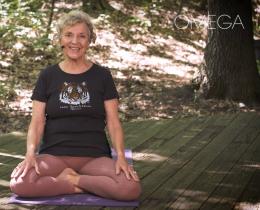Adolescence is a time of tremendous change for children physically and can be particularly intense emotionally. It is also a time when they are deeply engaged in self-discovery and exploring the inner workings and capacities of their identity.
This natural inclination offers an opportunity to introduce the experience of learning and practicing yoga as a meaningful support to the process of growing up. Programs that account for this age group’s tendency for risk-taking and vulnerability and allow youth to talk about their experiences can help them learn to make healthy and productive choices now and throughout their life.
Here are seven guidelines for yoga teachers, classroom teachers, school administrators, and parents to consider when establishing a school yoga program for tweens and teens.
1. Understand the Adolescent Mind
This is a vibrant time of life, and embracing the big energy of adolescence is the best way to introduce yoga to youth. In his book Brainstorm, Dr. Daniel Siegel says the adolescent mind is inclined to novelty seeking, social engagement, increased emotional intensity, and creative exploration. Often these qualities are assigned negative implications by adults, but a yoga program that embraces the upsides of these qualities can lead to strong community building and collaboration.
Questioning and pushing away from adults is important at this age, and not a sign that something is wrong with the adolescent or that they’re disrespectful. Yoga instructors can engage students more effectively by providing choices and building relationships and sharing practices that are relevant to where students are. By setting themselves firmly on their students’ side, instructors can effectively set boundaries and create safe spaces for exploration.
2. Support Healthy Identity Formation
Adolescents are actively forming their identity and working to develop a clear sense of self by exploring their values, ethics, racial and ethnic identity, sexual orientation, sexuality, and gender identity. Because they are self-conscious, self-centered, and have a strong need to fit in, they are also vulnerable to peer pressure. Peer pressure isn’t always bad—good friends can encourage teens to do well in school, express themselves fully, get involved in positive activities, volunteer, eat healthy foods, avoid drugs, alcohol and other risky activities, learn better social skills, and find better ways to communicate.
Peer pressure will remain part of a teen’s life into adulthood, and yoga can assist students in getting better at communicating their needs and boundaries, important skills for youth and adults. Modeling encouraging, respectful language and behavior in the classroom, encouraging students to stop if something doesn’t feel right, and offering instruction and modeling ways to communicate all support the development of healthy boundaries.
3. Create a Safe Space
Yoga providers have an opportunity to create a positive and nonjudgmental environment that supports the changes taking place in the adolescent brain. Working with this age group can be a balancing act—structure and clarity provides a sense of safety, but flexibility is also required to encourage exploration. There’s a fine line between what is challenging and what is threatening, and it may not be possible to know each student’s personal limits. Mistakes are an acceptable part of the process of learning and explicitly discussing them can help adolescents be more comfortable with the inevitable failures of life.
4. Address Students’ Needs
Adolescents will engage most willingly and fully with practices that seem relevant to them in the moment. This means instructors need to be attuned to their students and respectful of their circumstances. By shifting activities to fit the current needs of the group, yoga instructors can model how yoga practices can be used for self-care.
For example, if students come into class exhausted, the instructor can explore a practice to raise energy or one that creates space for rest and recuperation. If students arrive with chaotic or scattered energy, there is an opportunity to explore whether grounding work would be supportive, or if high-energy movement would be more helpful. Students will learn how to choose yoga tools for themselves by witnessing an instructor’s willingness to explore options.
5. Encourage Self-Directed Practice
Yoga can help adolescents navigate the challenges of daily life, and teachers can help them do that by offering instruction geared toward self-directed, independent practice to help them see yoga as a life skill rather than an extracurricular activity. Encourage student-centered conversations about how the practices can be used in everyday life, like falling asleep at night, taking a test, coming down when upset. Suggest at-home practice logs. Host parent/guardian-student educational events where parents or guardians and their children can practice yoga together. Suggest or provide educational materials in a variety of media to support everyday practice.
6. Be Discerning When Teaching Partner Work
Partner poses can help teens develop listening skills, build relational trust, and create ally identities, all of which support Social-Emotional Learning. However, since teachers may not have all the information essential to creating safety around partner work, poses should be optional and instructors should watch for and mitigate peer pressure.
Partner work also creates an important opportunity to discuss consent. Establishing guidelines for asking permission to touch and for accepting or rejecting touch help students learn to communicate with each other and understand that they can ask for or reject physical contact during any part of the experience.
7. Avoid Physical Touch
It’s not unusual for teachers in adult yoga classes to adjust students to enhance a pose. To prevent harm to students, misconceptions around sexual harassment, or other misunderstandings, touch is not recommended for school environments. Providing the option for students to “opt out,” as often happens in yoga studios, isn’t considered a strong enough stance for teaching yoga in schools.
Touch can sometimes send the message to a student they aren’t doing the poses correctly, aren’t good at practice, or need an external source to adequately control their body. By not receiving hands-on adjustments, students have an opportunity to increase their awareness of their own body and its needs. If students don’t understand a pose or are doing it unsafely, change the verbal instructions, take them out of the pose and reenter it with more specific instructions, or explore another aspect of the pose.



